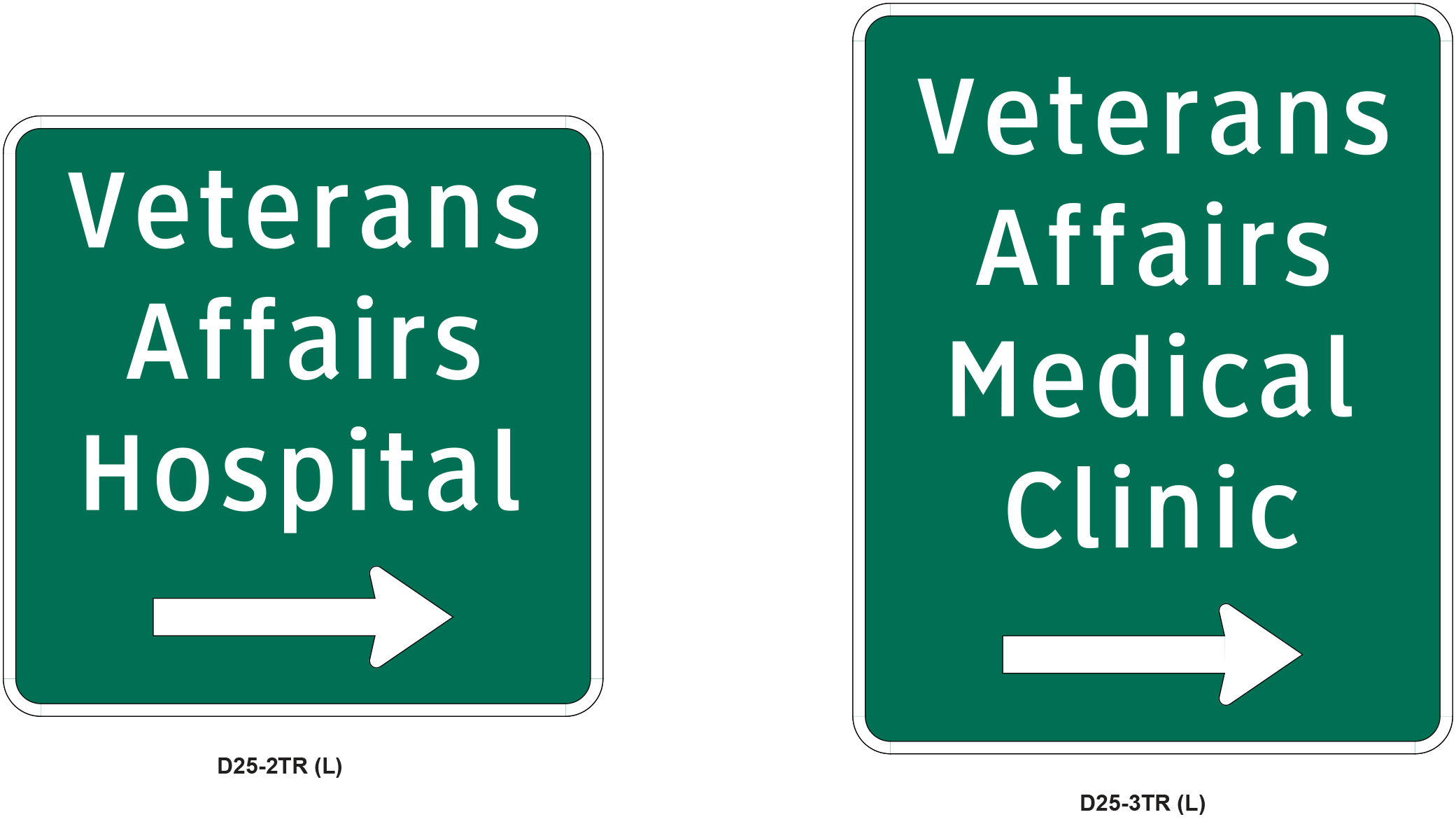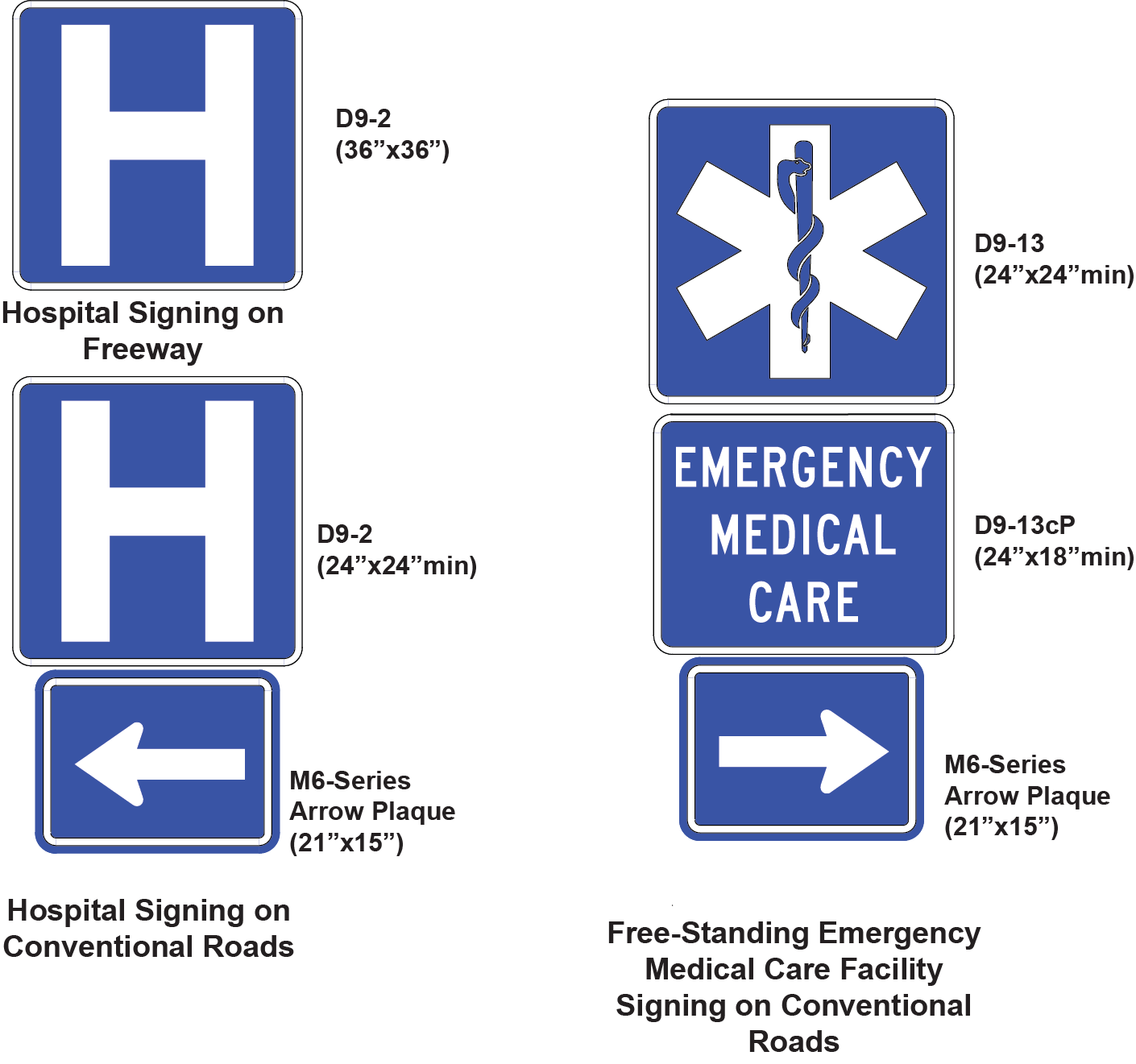Section 9: Traffic Generators
Anchor: #i1009419Signing for Traffic Generators
Signing for traffic generators and special events presents a challenge because of the wide variety of generators and their various sizes and locations in relation to highways. The Texas Manual on Uniform Traffic Control Devices (TMUTCD) contains a chart showing various generators and eligibility criteria for signing. Districts should follow these guidelines as closely as possible to maintain statewide consistency for signing requests.
Anchor: #i1009432Local Authority Requests for Traffic Generator Signs
Local authorities often request the Texas Department of Transportation (TxDOT) to sign for various traffic generators. The following guidelines apply.
Outside city limits: TxDOT may install signs for generators that meet the criteria established in Table 2M.2T of the TMUTCD on freeways and expressways.
Inside city limits:
- Anchor: #YRGYLQNR
- Cities may install such signs on conventional highways and frontage roads of freeways, provided they are agreed to by TxDOT and they do not conflict with or obstruct existing signing. (This is presently covered in municipal maintenance agreements.) Anchor: #YPAWCYTG
- Signs placed by the city must not be attached to existing TxDOT supports.
Signing for Traffic Generator Within the City Limits
As part of TxDOT's cost saving initiative stated in the series of "Removal of Unnecessary Signs" memos to all District Engineers, the city may provide traffic generator signs along conventional roadways under a Municipal Maintenance Agreement (MMA) or Wayfinding Program. The following is a list of typical traffic generators that a city can sign for under an MMA or the Wayfinding Program. The traffic generator needs to be within the city limits in order to meet eligibility requirements.
|
Arena |
Auditorium |
Business District |
|
City/County Office |
City/County Park |
Courthouse |
|
Golf Course |
Historic District |
Landfill |
|
Library |
Monument |
Power Plant |
|
School |
Sports Complex |
Stadium |
|
Zoo |
All Recreational and Cultural Interest Areas |
|
Anchor: #CEGCHHHB
Commercial Names
Traffic generators that meet the guidelines and have proper nouns such as “Ford Park” often hint at commercial signing. In this case the Ford Motor Company purchased the rights for the name of the facility, an entertainment center with various attractions. In these cases, TxDOT signs for the official name, regardless of its apparent commercial implication. On the other hand, a message such as “Sponsored by Ford Motor Company” would be deemed as advertising and would not be permitted under the standard set forth in Chapter 1A in Part 1 of the TMUTCD: “Traffic control devices or their supports shall not bear any advertising message or any other message that is not related to traffic control.”
Anchor: #i1009478Seasonal and Special Events Signing
Temporary signing on various routes to seasonal or special events attracting a large number of motorists should be provided similar to that for permanent generators. All temporary special-events signing must meet the requirements of Title 43 of the Texas Administrative Code (TAC), Section 22.15, and be approved by the Maintenance Division.
Anchor: #i1009490Airports
In cases where there is more than one international airport, a name plaque may be added above the airplane symbol sign to define which airport was being signed.
All of these signs should continue to be maintained.
Anchor: #i1080769Cemeteries
Signs for cemeteries may be installed based on the following eligibility criteria:
- Anchor: #JJBSBBFO
- Cemetery signs may be placed only on conventional (non-controlled access) roads. Cemetery signs should not be installed on expressways and freeways (controlled access) with the exception of Veteran Affairs Cemeteries. Anchor: #MPIOWSFM
- Cemeteries located outside the corporate limits of cities may be considered for signs. Signing for cemeteries within a city’s limits will be the responsibility of the city. Anchor: #QSUELMQB
- Cemeteries must be immediately adjacent to the signed highway or lie on a roadway intersected by the signed highway and be no greater than two miles from the signed highway. However, if the cemetery adjacent to the signed highway is clearly visible on the approach to the drive where a TxDOT sign would be redundant, the sign should not be installed. Anchor: #QJTDQHUL
- Cemeteries must have an unobstructed legible sign near the cemetery entrance designating the name of the cemetery. Anchor: #RMYGTJSK
- Cemeteries must be open to the public and accessible through an unlocked gate. The cemetery grounds should be adequately maintained and not hinder public access. Signs should not be installed for private and/or family cemeteries. Anchor: #FJCAGTWS
- Cemeteries that have been approved by the Texas Historical Commission as a historical cemetery shall have a sign with brown reflective background.
Cemeteries located on County Roads:
- Anchor: #MKIPIRSF
- Signs should be considered for only the highway intersection with the county road that is closer to the cemetery when the county road intersects the State highway at both ends. Anchor: #PGSWTPMA
- When more than one cemetery qualifies for signing, the cemetery closest to the intersection should appear as the first name on the sign, with the second to follow, etc.
There are two designs for cemetery signs, a generic cemetery (D3-3aT) sign and a named cemetery (D3-3bT) sign. Both designs can be found in the Standard Highway Sign Designs for Texas (SHSD). If signs are determined to be needed, the option of using generic or named cemetery signing is at the discretion of the district.
Anchor: #i1082140Veterans Facilities
TxDOT should install and maintain signs for all veterans hospitals (medical centers), clinics and cemeteries. Veteran facilities should be immediately adjacent to the signed highway or lie on a roadway intersected by the signed highway.
All veterans facility signs shall have a white legend with green background. While hospitals and clinics are normally signed for with blue background, a blue background sign may be misleading to non-veteran motorists seeking these services.
Figure 7-5. Examples of signing for veteran’s facilities
Anchor: #i1082354Emergency Medical Services
The purpose of emergency medical services signing is to guide motorists who are unfamiliar with the area to a medical care facility that can provide emergency medical treatment 24 hours a day, 7 days a week. The two types of facilities eligible for signing are:
- Anchor: #PIMRLBNM
- Licensed General Hospitals, and Anchor: #DPWJKQFG
- Licensed Free-Standing Emergency Medical Care Facilities in continuous operation.
Hospitals are eligible for signs on freeways/expressways and conventional roads while free-standing emergency medical care facilities are eligible for signs on conventional roads only. The two types of facilities have distinctly different standard signs as shown below. The requirements for the application of the signs are contained in the following pages. Also included are links to directories of licensed facilities through the Texas Department of State Health Services (DSHS).
Figure 7-6. Signing for Emergency Medical Services
Anchor: #i1082579Eligibility Requirements for Licensed General Hospitals
To be eligible for signing, licensed General Hospitals must:
- Anchor: #PHOIERDK
- be open to the general public Anchor: #YOMHSMVN
- have continuous operations (24 hours per day/7 days per week) Anchor: #NUJHLSTU
- have a doctor available at all times or a doctor on-call that can reach the facility within 30 minutes Anchor: #BUSGXJXO
- be licensed as per Chapter 241 of the Texas Health and Safety Code, and Anchor: #VXNPAIDS
- be listed in the DSHS directory of licensed general hospitals.
The hospital shall be located on the highway being signed or on the street or roadway which intersects the highway being signed. The hospital should be within 3 miles of the interchange for freeways/expressways and within 5 miles of the intersection for conventional roads.
When two or more qualifying hospitals are located such that access is provided via the same interchange or intersection, the facility nearest the interchange or intersection shall be the only facility signed.
When hospitals are located at consecutive intersections or at intersections in close proximity to each other, only the first (nearest) intersection or freeway exit in each direction shall be signed.
Anchor: #i1083078Sign Design
The standard D9-2 hospital symbol sign should be used to sign for qualifying licensed general hospitals. If supplemental freeway signing is used, the sign shall be fabricated as per freeway signing standards in the SHSD.
Sign assemblies on conventional roads should consist of the D9-2 hospital symbol sign and the Arrow Auxiliary (M6-series) plaque to indicate the direction to the services. A distance plaque may also be used if necessary.
The name of the hospital is not included on the sign in order to provide a fair and consistent treatment of all eligible hospitals as well as providing uniform signing for hospitals throughout the state.
Anchor: #i1083170Sign Placement
If used on conventional roads, one sign per direction may be placed in advance of the cross street where the hospital resides. If used on freeways, the hospital plaque should be used on all advance guide signs and the exit directional sign for a particular exit. If the hospital is not visible from the ramp or frontage road, the signing should be repeated in smaller size at the intersection of the frontage road and the crossroad.
Anchor: #i1115813Eligibility Requirements for Signing of Licensed Free-Standing Emergency Medical Care Facilities
To be eligible for signing, licensed free-standing emergency medical care facilities must:
- Anchor: #LTOVSTOS
- be open to the general public Anchor: #XNVLKJKO
- have continuous operations (24 hours per day/7 days per week) Anchor: #WXIKFDYW
- have a doctor available at all times or a doctor on-call that can reach the facility within 30 minutes Anchor: #PDRWXWME
- be licensed as per Chapter 254 of the Texas Health and Safety Code, and Anchor: #HBALWKGT
- be listed in the DSHS directory of licensed free-standing emergency medical care facilities.
The free-standing emergency medical care facility shall be located on the highway being signed or on the street or roadway which intersects the highway being signed. The facility should be within 5 miles of the intersection.
When two or more qualifying free-standing emergency medical care facilities are located such that access is provided via the same intersection, the facility nearest the intersection shall be the only facility signed.
When a qualifying free-standing emergency medical care facility and a qualifying hospital are located such that access is provided via the same intersection, the hospital should be the only facility signed.
Anchor: #i1083686Sign Design
The Emergency Medical Services (D9-13) symbol sign with the EMERGENCY MEDICAL CARE (D9-13cP) plaque should be used to sign for qualifying licensed free-standing emergency medical care facilities. A directional Arrow Auxiliary (M6-Series) plaque should be used to indicate the direction to the services and a distance plaque may be used if necessary. The name of the facility is not included on the sign in order to provide a fair and consistent treatment of all eligible facilities as well as providing uniform signing for emergency care facilities throughout the state.
Anchor: #i1083732Sign Placement
Free-standing emergency medical service facility signs may be used on conventional roads only. One sign assembly per direction may be placed in advance of the cross street where the free-standing emergency medical care facility resides.
Anchor: #i1083781Exemptions from Licensing Requirements for Free-Standing Emergency Medical Care Facilities
Some free-standing emergency medical care facilities may be exempt from licensing requirements. Facilities are exempt from licensing if the facility is owned or operated by a licensed hospital or by a hospital owned and operated by the state and are:
- Anchor: #JHMNBMKS
- surveyed as a service of the hospital by an organization that has been granted deeming authority as a national accreditation program for hospitals by the Centers for Medicare and Medicaid Services; or Anchor: #VTXOUXQB
- granted provider-based status by the Centers for Medicare and Medicaid Services.

